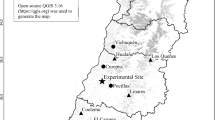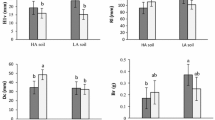Abstract
The exotic trees Ailanthus altissima, Robinia pseudoacacia, Acer negundo and Elaeagnus angustifolia coexist with the native trees Fraxinus angustifolia and Ulmus minor in river banks of central Spain. Similarly, the exotic trees Acacia dealbata and Eucalyptus globulus co-occur with the natives Quercus pyrenaica and Pinus pinaster in Northwest Spain. We aimed to identify the environmental conditions that favour or hamper the establishment success of these species. In spring 2008, seeds of the studied species were sown under an experimental gradient of light (100, 65, 35, 7% of full sunlight) combined with three levels of soil moisture (mean soil water potential = −0.97, −1.52 and −1.77 MPa.). During the first growing season we monitored seed emergence and seedling survival. We found that the effect of light on the establishment success was stronger than the effect of soil moisture. Both exotic and native species of central Spain showed a good performance under high light, A. negundo being the most shade tolerant. Water shortage diminished E. angustifolia and A. altissima success. Among NW Spain species, A. dealbata and P. pinaster were found to be potential competitors for colonizing high-irradiance scenarios, while Q. pyrenaica and E. globulus were more successful under moderate shade. High soil moisture favoured E. globulus but not A. dealbata establishment. These results contribute to understand some of the factors controlling for spatial segregation between coexisting native and exotic tree species, and can help to take decisions orientated to the control and management of these exotic species.




Similar content being viewed by others
References
Babu RC, Kandasamy O (1997) Allelopathic effect of Eucalyptus globulus Labill on Cyperus rotundus L and Cynodon dactylon L Pers. Journal of Agronomy and Crop Science 179:123–126
Baruch Z, Bilbao B (1999) Effects of fire and defoliation on the life history of native and invader C-4 grasses in a Neotropical savanna. Oecologia 119:510–520
Boring LR, Swank WT (1984) The role of black locust (Robinia pseudoacacia) in Forest Succession. Journal of Ecology 72:749–766
Call LJ, Nilsen ET (2003) Analysis of spatial patterns and spatial association between the invasive tree-of-heaven (Ailanthus altissima) and the native black locust (Robinia pseudoacacia). American Midland Naturalist 150:1–14
Carballeira A, Reigosa MJ (1999) Effects of natural lecheates of Acacia dealbata Link in Galicia (NW Spain). Botanical Bulletin of Academia Sinica 40:87–92
Castro J (2006) Short delay in timing of emergence determines establishment success in Pinus sylvestris across microhabitats. Annals of Botany 98:1233–1240
Castro-Díez P, Navarro J, Pintado A, Sancho LG, Maestro M (2006) Interactive effects of shade and watering on the performance of seedlings of three Mediterranean Quercus species. Tree Physiology 26:389–400
Castro-Díez P, Navarro J, Maestro M (2007) Effects of moderate shade and irrigation with eutrophicated water on the nitrogen economy of Mediterranean oak seedlings. Flora 203(3):243–253
Catalán Bachiller G (1993) Semillas de árboles y arbustos forestales. Colección Técnica Ministerio de Agricultura, Pesca y Alimentación ICONA, Madrid
Chytrý M, Maskell LC, Pino J, Pysek P, Vilà M, Font X, Smart SM (2008) Habitat invasions by alien plants: a quantitative comparison among Mediterranean, subcontinental and oceanic regions of Europe. Journal of Applied Ecology 45:448–458
Daehler CC (2003) Performance comparisons of co-occurring native and alien invasive plants: implications for conservation and restoration. Annual Review of Ecology, Evolutions and Systematics 34:183–211
Deka RN, Wairiu M, Mtakwa PW, Mullins CE, Veenendaal EM, Townend J (1995) Use and accuracy of the filter-paper technique for measurement of soil matric potential. European Journal of Soil Science 46:233–238
DeWine JM, Cooper DJ (2007) Effects of river regulation on riparian box elder (Acer negundo) forest in canyons of the upper Colorado River basin, USA. Wetlands 27:278–289
DeWine JM, Cooper DJ (2008) Canopy shade and the successional replacement of tamarisk by native box elder. Journal of Applied Ecology Ecol 45:505–514
Erfmeier A, Bruelheide H (2005) Invasive and native Rhododendron ponticum populations: is there evidence for genotypic differences in emergence and growth? Ecography 28:417–428
Ferreras AE, Galetto L (2010) From seed production to seedling establishment: important steps in an invasive process. Acta Oecologica 36:211–218
García-Fayos PC (2001) Bases ecológicas para la recolección, almacenamiento y germinación de semillas de especies de uso forestal en la Comunidad Valenciana. Banc de Llavors Forestals, Conselleria de Medi Ambient, Valencia
González E, González-Sanchís M, Cabezas A, Comín FA, Muller E (2010) Recent changes in the riparian forest of a large regulated Mediterranean river: Implications for management. Environmental Management 45:669–681
Grime JP (1977) Evidence for the existence of three primary strategies in plants and its relevance to ecological and evolutionary theory. American Naturalist 111:1169–1194
Grotkopp E, Rejmánek M (2007) High seedling relative growth rate and specific leaf area are traits of invasive species: phylogenetically independent contrasts of woody angiosperms. American Journal of Botany 94(4):526–532
Jones RH, Sharitz RR (1989) Potential advantages and disadvantages of germinating early for trees in floodplain forests. Oecología 81:443–449
Jung SC, Matsushita N, Wu BY, Kondo N, Shiraishi A, Hogetsu T (2009) Reproduction of a Robinia pseudoacacia population in a coastal Pinus thunbergii windbreak along the Kujukurihama Coast, Japan. Journal of Forest Research 14:101–110
Kabeya D, Sakai S (2003) The role of roots and cotyledons as storage organs in early stages of establishment in Quercus crispula: a quantitative analysis of the non-structural carbohydrate in cotyledons and roots. Annals of Botany 92:537–545
Knapp LB, Canham CD (2000) Invasion of an old growth forest in New York by Ailanthus altissima: sapling growth and recruitment in canopy gaps. Journal of the Torrey Botanical Society 127:307–315
Kowarik I, Saumel I (2007) Biological flora of Central Europe: Ailanthus altissima (Mill) Swingle Pers. Perspectives in Plant Ecology, Evolution and Systematics 8:207–237
Lorenzo P, Pazos-Malvido E, González L, Reigosa MJ (2008) Allelopathic interference of invasive Acacia dealbata: Physiological effects. Allelopathy Journal 22:452–462
Lorenzo P, González L, Reigosa MJ (2010) The genus Acacia as invader: the characteristic case of Acacia dealbata Link in Europe. Annals of Forestry Science 67:101–111
Lorenzo P, Palomera-Pérez A, Reigosa MJ, González L (2011) Allelopathic interference of invasive Acacia dealbata Link on the physiological parameters of native understory species. Plant Ecology 212:403–412
Mahoney JM, Rood SB (1992) Response of an hybrid poplar to water table decline in different substrates. Forest Ecology and Management 54:141–156
Mahoney JM, Rood SB (1998) Streamflow requirements for cottonwood seedling recruitment- an integrative model. Wetlands 18:634–645
Masaka K, Yamada K (2009) Variation in emergence character of Robinia pseudoacacia L (Leguminosae) seeds at individual tree level. Journal of Forest Research 14:167–177
Miller TE, Winn AA, Schemske DW (1994) The effects of density and spatial distribution of selection for emergence time in Prunella vulgaris (Lamiaceae). American Journal of Botany 81:1–6
Mitrakos KA (1980) A theory for Mediterranean plant life. Acta Oecologica 1:245–252
Molina A, Reigosa MJ, Carballeira A (1991) Release of allelochemical agents from litter, throughfall, and topsoil in plantations of Eucalyptus globulus labill in Spain. Journal of Chemical Ecology 17:147–160
Niinemets Ü, Valladares F (2006) Tolerance to shade, drought, and waterlogging of temperate Northern hemisphere trees and shrubs. Ecological Monographs 76:521–547
Orshan G (1989) Plant Pheno-Morphological Studies in Mediterranean Type Ecosystems. Kluwer Academic Publishers, Dordrecht
Pattison RR, Goldstein G, Ares A (1998) Growth, biomass allocation and photosynthesis of invasive and native Hawaiian rainforest species. Oecologia 117:449–459
Perglová I, Pergl J, Skálová H, Moravcová L, Jarosík V, Pysek P (2009) Differences in germination and seedling establishment of alien and native Impatiens species. Preslia 81:357–375
Piotto B, Di Noi A (2001) Propagation of Mediterranean trees and shrubs from seed APAT––Agency for the protection of the environment and for technical services
Pysek P, Richardson DM (2007) Traits associated with invasiveness in alien plants: where do we stand. In: Nentwig, W (Ed). Biological Invasions Springer-Verlag, Berlin and Heidelberg, pp 97–125
Sánchez-Gómez D, Valladares F, Zavala MA (2006a) Performance of seedlings of Mediterranean woody species under experimental gradients of irradiance and water availability: trade-offs and evidence for niche differentiation. New Phytologist 170:795–806
Sánchez-Gómez D, Zavala MA, Valladares F (2006b) Seedling survival responses to irradiance are differentially influenced by low water availability in four tree species of the Iberian cool temperate-Mediterranean ecotone. Acta Oecologica 30:322–332
Sanz Elorza, M, Dana Sánchez, ED, Sobrino Vespertinas, E (2004) Atlas de plantas alóctonas invasoras en España. Ministerio de Medio Ambiente Madrid
Seiwa K (2000) Effects of seed size and emergence time on tree seedling establishment: importance of developmental constraints. Oecologia 123:208–215
Shafroth PB, Auble GT, Scott ML (1995) Emergence and establishment of the native plains cottonwood (Populus deltoides Marshall subsp monilifera) and the exotic Russian-Olive (Elaeagnus angsutifolia L). Conservation Biology 9:1169–1175
Valladares F (2004a) Ecología del bosque mediterráneo en un mundo cambiante. Ministerio de Medio Ambiente Organismo Autónomo de Parques Naturales, Madrid
Valladares F (2004b) Global Change and radiation in Mediterranean forest ecosystems: a meeting point for ecology and management. In: Arianoutsou M, Papanastasis V (eds) Ecology, conservation and sustainable managements of Mediterranean type ecosystems of the world. Millpress, Rotterdam, pp 1–4
Verdú M, Traveset A (2005) Early emergence enhances plant fitness: a phylogenetically controlled meta-analysis. Ecology 86:1385–1394
Weber E (2003) Invasive plant species of the world. A reference guide to environmental weeds. CABI Publishing, Zurich
Zar JH (1999) Biostatistical Analysis. Prentice Hall, Upper Saddle River, New Jersey
Acknowledgments
This study was supported by the projects CGL2007-61873/BOS, CGL2010-16388/BOS of the Spanish Ministry of Science and Innovation and POII10-0179-4700 of the Junta de Comunidades de Castilla-La Mancha. Noelia González-Muñoz was supported by a grant of the SMSI (FPI fellowship, BES-2008-002457) and by a grant of Alcalá University. We acknowledge Rosendo Elvira and the staff of the Alcalá University Botanical Garden for their support to perform this experiment. We are grateful to the support of the REMEDINAL-2network (Comunidad de Madrid). We also thank Evelyn Beliën for her valuable help with the plant measurements.
Author information
Authors and Affiliations
Corresponding author
Electronic supplementary material
Below is the link to the electronic supplementary material.
Rights and permissions
About this article
Cite this article
González-Muñoz, N., Castro-Díez, P. & Fierro-Brunnenmeister, N. Establishment Success of Coexisting Native and Exotic Trees Under an Experimental Gradient of Irradiance and Soil Moisture. Environmental Management 48, 764–773 (2011). https://doi.org/10.1007/s00267-011-9731-3
Received:
Accepted:
Published:
Issue Date:
DOI: https://doi.org/10.1007/s00267-011-9731-3




